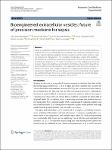Thông tin tài liệu
Thông tin siêu dữ liệu biểu ghi
| Trường DC | Giá trị | Ngôn ngữ |
|---|---|---|
| dc.contributor.author | Aina, Areny-Balagueró | - |
| dc.contributor.author | Anna, Solé-Porta | - |
| dc.contributor.author | Marta, Camprubí-Rimblas | - |
| dc.date.accessioned | 2023-03-16T04:29:26Z | - |
| dc.date.available | 2023-03-16T04:29:26Z | - |
| dc.date.issued | 2023 | - |
| dc.identifier.uri | https://link.springer.com/article/10.1186/s40635-023-00491-w | - |
| dc.identifier.uri | https://dlib.phenikaa-uni.edu.vn/handle/PNK/6929 | - |
| dc.description | CC BY | vi |
| dc.description.abstract | Sepsis is a syndromic response to infection and is frequently a final common pathway to death from many infectious diseases worldwide. The complexity and high heterogeneity of sepsis hinder the possibility to treat all patients with the same protocol, requiring personalized management. The versatility of extracellular vesicles (EVs) and their contribution to sepsis progression bring along promises for one-to-one tailoring sepsis treatment and diagnosis. In this article, we critically review the endogenous role of EVs in sepsis progression and how current advancements have improved EVs-based therapies toward their translational future clinical application, with innovative strategies to enhance EVs effect. More complex approaches, including hybrid and fully synthetic nanocarriers that mimic EVs, are also discussed. Several pre-clinical and clinical studies are examined through the review to offer a general outlook of the current and future perspectives of EV-based sepsis diagnosis and treatment. | vi |
| dc.language.iso | en | vi |
| dc.publisher | Springer | vi |
| dc.subject | future of precision medicine for sepsis | vi |
| dc.subject | versatility of extracellular vesicles | vi |
| dc.title | Bioengineered extracellular vesicles: future of precision medicine for sepsis | vi |
| dc.type | Book | vi |
| Bộ sưu tập | ||
| OER- Y học- Điều dưỡng | ||
Danh sách tệp tin đính kèm:

